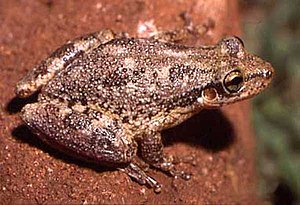Nose knuckle-toed tree frog
| Nose knuckle-toed tree frog | ||||||||||||
|---|---|---|---|---|---|---|---|---|---|---|---|---|

Common nosed tree frog ( Scinax nasicus ) |
||||||||||||
| Systematics | ||||||||||||
|
||||||||||||
| Scientific name | ||||||||||||
| Scinax nasicus | ||||||||||||
| ( Cope , 1862) |
The neotropic nasal crease toes tree frog ( Scinax nasicus ) belongs to the subfamily scinax (Scinaxinae) within the family of tree frogs . According to Faivovich et al. (2005) the species within the genus Scinax belongs to the Scinax ruber clade. Edward Drinker Cope described the species on the basis of a specimen collected from the Paraná basin from the "Thomas J. Page Expedition".
Systematics
Scinax nasicus probably represents a complex of several species and needs a taxonomic revision .
Synonyms
- Hyla nasica Cope, 1862
- Hyla nigra Cope, 1887
- Hylella anisitsi Méhely, 1904
- Hyla x-signata nasica Lutz, 1973
- Hyla anisitzi Duellman, 1977
- Ololygon nasica Fouquette & Delahoussaye, 1977
- Ololygon nasicum Laurent & Teran, 1981
- Scinax nasica Duellman & Wiens, 1992
Köhler & Böhme (1996) corrected the ending of the epithet .
distribution
The species comes at heights of up to 1000 m above sea level. NN in Paraguay , northern Argentina , Uruguay , eastern Bolivia and Brazil from the southwest to the state of Rio Grande do Sul .
description
The males reach a head-torso-length (KRL) of 27–32 mm, the females up to 35 mm. De la Riva (1993), however, gives a mean KRL of 35.3 mm for six adult males from Bolivia . The back is brown, yellowish, or greyish with one or two interocular spots and variable, often indistinct, X-like back markings. The belly is white. The inner thighs and the groin area are yellow and brown. In contrast to other representatives of the genus, the hind legs are shorter and the snout more pointed. Bolivian individuals usually have pale dark spots on their backs. The larvae are high-finned and have a translucent white body with a fine network of veins.
Habitat and Ecology
The common nasal tree frog lives in forests, scrub and grassland and uses temporary water in open land for reproduction. After rains, the activity of the males increases and they usually call from vegetation near the spawning waters. The free-swimming tadpoles, which are supsension and upbringing eaters, hatch from the spawn, which is dark on top and is attached to aquatic plants. Outside the spawning season, the common nosed tree frog is mostly found on trees.
Danger
The IUCN lists the nasal tree frog as "Least Concern". Its wide distribution and the fact that the species can adapt relatively well to anthropogenic changes, adopts a broad spectrum of habitats, the total population shows a stable trend and is estimated to be sufficiently large, explain this. The processors consider it unlikely that stocks of the species can decline quickly enough to justify a higher endangerment level. As already mentioned, a taxonomic revision of this species complex is required, which could change the situation. In addition, the common nasal tree frog is found in its area in several protected areas.
literature
- Cope, ED (1862): Catalogs of the reptiles obtained during the explorations of the Parana Paraguay, Vermejo and Uruguay rivers, by Capt. Thos. J. Page, USN; and of those procured by Lieut. N. Michier, US Top. Eng., Commander of the expedition conducting the survey of the Atrato River. I. The Paraguay collection . Proc. Acad. Nat. Sci. Philadelphia 1862: 354.
- De la Riva, I. (1993): A new species of Scinax (Anura, Hylidae) from Argentina and Bolivia . Journal of Herpetology 27 (1): 41-46.
- Faivovich, J., Haddad, CFB, Garcia, PCA, Frost, DR, Campbell, JA & WC Wheeler (2005): Systematic review of the frog family Hylidae, with special reference to Hylinae: Phylogenetic analysis and taxonomic revision. Bulletin of the American Museum of Natural History 294, 240 pp.
- Frost, DR (2009): Amphibian Species of the World: an Online Reference . Version 5.3 (February 12, 2009). Electronic Database accessible at Amphibian Species of the World . American Museum of Natural History, New York, USA.
- Köhler, J. & W. Böhme (1996): Anuran amphibians from the region of Pre-Cambrian rock outcrops in northeastern Bolivia, with a note on the gender of Scinax Wagler, 1830 (Hylidae) . Revue Française d'Aquariologie, Herpétologie 23: 133–140.
- Kwet, A., Aquino, L., Reichle, S., Silvano, D., Lavilla, E., di Tada, I. & J. Langone (2004): Scinax nasicus . In: IUCN (2010): IUCN Red List of Threatened Species . Version 2010.1. IUCN Red List of Threatened Species . Downloaded on March 29, 2010.
- ↑ a b c Kwet, A. Frogs-Frogs-Anuros - Album Rio Grande do Sul - Nose Knickzehenlaubfrosch
- ↑ De la Riva, I. (1993): A new species of Scinax (Anura, Hylidae) from Argentina and Bolivia . Journal of Herpetology 27 (1): 41-46.
- ↑ a b Kehr, AI & MI Duré (1995): Descripción de la larva de Scinax nasica (Cope, 1862) (Anura, Hylidae) . Facena 11: 99-103.
Web link
- Scinax nasicus inthe IUCN 2013 Red List of Threatened Species . Posted by: Axel Kwet, Lucy Aquino, Steffen Reichle, Débora Silvano, Esteban Lavilla, Ismael di Tada, Jose Langone, 2004. Retrieved October 4, 2013.